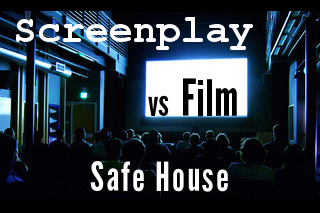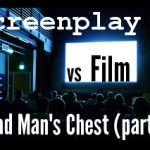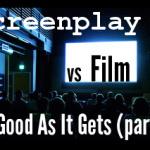Safe House stars Denzel Washington as Tobin Frost, a rogue agent who’s sent to a South African safe house overseen by an inexperienced CIA agent, Matt Weston, (played by Ryan Reynolds).
But as it turns out, the safe house is anything but safe.
Safe House doesn’t take the action movie genre to a whole new level (and Vera Farmiga’s character bears more than a striking resemblance to Joan Allen’s Pamela Landy in the Bourne movies), but it’s a decent flick.
Judging from the $126 million box office take (domestic) and the generally positive reviews on Amazon, it also pleased more than one movie-goer looking for an action-packed thriller.
On the whole, the script was fairly similar to the produced movie, but there are a few key differences which make for good screenplay vs film analysis.
A lot of the writing tips are especially pertinent to spy movies, so if you’re writing a CIA thriller, you’ll want to study this post carefully!
Screenwriting Tip #1: Bring in the big guns
In the Safe House screenplay, Tobin Frost secured highly classified documents, contained within a microchip, from one Milan Maxim.
INT. RIO STRIP CLUB – DAY
Low-rent and seedy. MILAN MAXIM sits in a VIP booth. 33. Serbian. Two girls on either side, he drinks and smokes heavily.
In the movie, Frost acquired the documents from Alec Wade, an MI6 agent. That’s a big difference. MI6 is a “big gun;” a random Serb is not.
Honestly, how many moviegoers can identify where Serbia is on a map? MI6 is a different story. With MI6 comes a whole host of connotations (a famous one being James Bond).
These connotations infuse the the documents with extra intrigue, explaining why Frost is so invested in them…and compelling the audience to become invested in them as well. The MI6 factor adds an extra thrill to the script. It’s a subtle thrill, but a thrill nevertheless.
Screenwriting Tip #2: Creating mystique
Mystique automatically comes with the spy profession. (Although Betty Friedan might disagree!) Still, there are ways to increase the mystique of the spy starring in your script, and studying Safe House provides some good pointers.
What is your spy’s specialty?
Spies come in all shapes and sizes and skill sets. What’s your spy’s special area of expertise? Choosing an intriguing skill will add to your character’s aura of mystery.
For example, in the Safe House movie, when the CIA reviews Frost’s dossier, they say he “tested off the charts in psychological fieldwork…successfully questioned, recruited and flipped several high-ranking individuals. Simply put, he’s an expert manipulator of human assets.”
These are not skills you find in the average spy. They not only add an extra bit of mystique to Frost’s character, but also distinguish Frost from CIA spy characters in other thrillers.
How do spy organizations (his own or rival ones) react to him?
Frost sells CIA secrets to the highest bidder, so he’s not exactly welcome at the CIA. But there’s more to the suits’ response to Frost than resentment. There’s fear as well.
In the Safe House movie, one agent, Linklater, alerts Weston about Frost’s arrival at the safe house. The file she sends over describes Frost as a high profile asset and warns Weston to keep a 2 meter perimeter around the asset at all times.
If the CIA says you need to proceed with extreme caution when dealing with Frost, then Frost is seriously skilled, again adding to his aura of omnipotence.
How many people do they send to take him down?
If your spy is as potent as Keyser Soze, then treat him that way.
Send only the best after him, the most skilled. And send a lot of ’em too.
In the Safe House script, pretty much only a bad guy named Vargas chases Frost up to the fringes of the American Consul. Vargas is a skilled sniper and a lethal looking dude, but if Frost is as capable as the CIA is making him out to be, then I expect Frost to be able to elude Vargas. After all, Vargas is just ONE guy; and Frost is supposed be THAT good.
In the movie, Vargas and a whole host of his henchmen arrive outside the Consul. Having Vargas arrive with plenty of backup solidified Frost’s badass status.
Plus, Frost’s odds look really bad, and seeking refuge at the Consul seems like his only viable choice…instead of a contrivance to get him at a certain place by a certain time because the plot required it.
Screenwriting Tip #3: Midpoints are not a place for subtlety
The midpoint of an action movie or thriller should be full of action or thrills, like the midpoint of Sherlock Holmes, for example. In addition to action/thrills, the midpoint usually shifts the second act in a new direction, changing the dynamic of your script in some way.
In both the Safe House script and movie, the midpoint was full of action–Frost breaks free of Weston at a crowded soccer stadium, in a country where soccer equals oxygen. Not to mention the stadium is patrolled by abundance of local police who have no idea that Weston’s part of the CIA.
It also turned the tides of the second act, as the power between Frost and Weston shifted. Soon after Frost eludes Weston, Frost becomes uncuffed and free–much more in control of where he’s going than he had been for the first half of the movie.
Still, the midpoint in the script was a shade too subtle.
Moving, Frost eyes something:
A COP
standing post not too far away — stadium security — making sure everything is copacetic.
Frost gets an idea — continues forward with Matt — and covertly BUMPS a passing SOCCER FAN, causing him to drop the jacket —
— masking the cuffs. The Cop catches sight of the restraints, eyes narrowing.
Frost then makes a gun sign with his hand which, again, the cop picks up on.
RESUME:
Frost apologizes to the man he “hit” —
FROST (CONT’D)
Lamento.
— and continues on with Matt — who throws the jacket back onto Frost’s hands.
THE COP
watching them disappear, keeps a closer eye on Matt. Spots a GUN BULGE in his jacket. He immediately breaks out his walkietalkie — calling this in — as we CUT TO —
INT. MARACANÃ STADIUM – LOCKER BANK – CONTINUOUS
Narrowed eyes?
Hand signals?
You don’t want hand signals at your midpoint. You want drama.
Thankfully, in the movie, we got more drama.
Instead of subtly signaling to a local cop, Frost raises his cuffed hands in the air, and cries, “He’s trying to kidnap me! He’s trying to kidnap me!” In the words of Luc Besson, scribe of Taken, that’s a real attention getter.
You can just feel the frustration emanating from Weston as he doesn’t know how to handle this particular wrinkle. (You can also tell Denzel Washington enjoyed hamming it up.)
The midpoint is no place for subtlety, it’s a plot point that should really pack a punch.
Be as dramatic as you can, without a) being melodramatic and b) writing a scene so epic it completely overshadows your climax.
Screenwriting Tip #4: the point of commitment can get the audience to commit
The next crucial plot point to follow the midpoint is the point of commitment.
Like I said in the 8 essential plot points every script outline should have, the point of commitment is not something I thought about very much until I read Vicki King’s How to Write a Movie in 21 Days.
She describes it as a point:
where your main character reaffirms his commitment to his goal, usually around page 60 of your script
A point of commitment can really enhance a script, especially the second half of Act Two because watching characters make tough decisions always makes for compelling cinema.
In the Safe House movie, the director, Daniel Espinosa, really highlighted Weston’s commitment to earning the approval of his CIA superiors in order to get his long-awaited promotion.
By this point, Weston’s escaped from the local police at the stadium, and he’s in hot pursuit of Frost who’s disappeared into a train station. Weston is thisclose to catching Frost, but one of the local policemen is on Weston’s tail.
The cop pulls out his weapon. Weston has a choice: he can dispatch the cop or he can let Frost escape. Weston shoots, the first time we see him be so brutal. The guard crumples to the ground, but it’s unclear whether the wound is mortal or not.
What is clear is Weston’s commitment to his goal and his willingness to take out someone who has not done him any harm in order to achieve his objective.
It’s a scene that stands out from the rest of the movie, a scene that’s still with me. That’s the power of a well-executed point of commitment. They can help lasso in audience engagement during the critical period between your midpoint and your “all is lost” moment.
Screenwriting Tip #5: Heroes should be active
In both the film and the movie, Weston tells his girlfriend Ana the truth about his job. At this point he doesn’t have to, but he does anyway. This decision reveals more of his character.
But in the script, after making this character-revealing decision, he leaves all the cards in her hands.
INT. ANA’S APARTMENT – SAME
Matt writes Villar’s location onto a pad. Tears out the paper. Quickly gets to his feet.
MATT
I gotta go.
He swipes a pair of keys off the desk.
MATT (CONT’D)
I need to borrow your car.
He turns to Ana — locking eyes.
MATT (CONT’D)
I’m sorry again about this. If you don’t want to see me —
ANA
I don’t.
Her bluntness stops him.
ANA (CONT’D)
Not ever.
MATT
Ana —
He steps to her. She puts up her hand.
ANA
Just go.
A beat. That kills him. But she won’t budge — Frost was right.
In the script, it’s Ana’s decision to leave Weston. But Ana is a two-bit player. We don’t really care about her choices, we care about Weston’s choices.
He should be the most active character, making the tough decisions. His choices should be put under a microscope.
That’s how it played out in the movie. In the film, Weston gives Ana money and a ticket to Paris, urging her to leave immediately. In his attempt to protect her, he’s not passively accepting her decision, but actively seeking his own goals. (And in a rather heroic way too!)
If Ana’s character had a larger role in the movie, then having her make active decisions would be warranted. But since she’s not, Weston should be the one calling the shots.
Screenwriting Tip #6: Avoid introducing new characters late in the game
After the midpoint of your movie, it’s much more effective if you don’t add new characters to your script. Instead, enhance and expand the roles of characters you’ve already introduced. As Alex Epstein notes in Crafty Screenwriting:
Try to merge your characters. The more time we spend with your characters, the more we care about them. If you can merge your characters without losing drama, you should.
Why should you try to merge your characters? For one thing, introducing fewer characters is less work for you. You don’t have to brainstorm more backstories or come up with pithy–but revealing–character descriptions.
For another thing, the audience can only become invested in so many characters. After a certain point, no matter how intriguing a fellow may be, a reader just doesn’t want to get to know him. He wants to focus on the characters he’s already been introduced to.
If your audience isn’t inclined to invest in characters which are introduced late in your script, you’re definitely fighting an up-hill battle.
Finally, adding NEW characters almost invariably slows down your script, something you don’t want to do, especially during the second half of Act Two, where most scripts drag like hell.
No matter how artfully you write the introductions, they bring the pace to a halt just when you should be ratcheting it up.
Take this example from the Safe House script:
INT. UNDERGROUND BOXING CLUB – NIGHT
A dingy basement somewhere. Stench of sweat and blood.
TWO MEN — one AFRICAN — other ALBANIAN — are pummelling each other to near death — as a crowd of drunk and rowdy onlookers CHEER them on.
The fighters swap punches — kicks — bones BREAK — blood SPLATTERS — teeth FLY.
The larger African BLOCKS a hard right — catching the Albanian’s arm — SWINGING back his elbow — CLOCKING his attacker in the jaw.
He KICKS him in the stomach. The Albanian reels back against the people circling “the ring”.
They CATCH him before he falls — THROW him back into the fray.
The African HURLS a hook — but the Albanian still has the strength and state of mind to BLOCK the punch and —
— in A LIGHTNING FAST MOVE — THROWS a palm into his throat –
– HURLS him to the floor — SLAMS his head hard against the floor — while raising his other hand — now clenched — about to hammer his face in when:
NEW ANGLE — A PLASTIC BASKET
containing the fighters’s wallets — keys — and cell phones. Simultaneously both phones starts BUZZING.
RESUME:
Hearing this — the Albanian STOPS himself — RELEASES his grip — the African GASPS for breath.
Both men turn — look to their ringing phones. They are the FREELANCERS — and they have just been hired.
Yes, this is a dramatic, visceral introduction, but it slowed down the momentum of the script. At this point, Frost has escaped from Weston, and I’m much more interested in how Weston’s going to get him back than I am in two brutal fighting machines, whom I’m meeting for the first time.
This introduction would’ve worked if the brutes weren’t new characters, but pre-existing ones–and their fight scene was described earlier on in the screenplay draft.
Then when they pop out of the woodwork to destroy both Frost and Weston, the pace during the second half wouldn’t have to slow down to introduce them.
The movie didn’t keep the fight scene, but it did include these two villainous characters from the very beginning. When Vargas chases Frost to the fringes of the Consul all the way back in Act One, Vargas is accompanied by a slew of mercenaries.
These mercenaries later hunt down Frost and Weston, almost killing them during the second half of Act Two, until Frost and Weston overpower the hit men in hand to hand combat. This way, the action didn’t come to a sluggish halt in order to play “getting to know you.”
Screenwriting Tip #7: Theme matters
Theme is one of the hardest elements to incorporate into a screenplay, and personally, it’s one of my weakest writing skills. If you, like me, need to brush up on your theme skills, read this article on theme over at the Scriptshadow screenwriting blog.
It’s worth reading in its entirety, but I wanted to focus on this particular advice given by TV writer Tawnya Bhattacharya:
You are expressing it through character, relationships, conflict, dialogue, symbolism and visual imagery…but hopefully you’re being subtle about it so you aren’t hitting people over the head…
…if you are proving the opposite thematic point of view through a secondary character or storyline as well as your main thematic point with primary characters, then you are giving us perspective and will hopefully steer clear of becoming preachy.
If we examine Safe House through Tawyna’s lens, we can see all the different ways it tackled its thematic matter. But first..what’s the theme of this thriller anyway?
To me, the theme of Safe House centers around truth and lies, more specifically, “what kind of life can you live if your life is built on a pack of lies?”
What are the concrete ways Safe House explores this theme? Hopefully, by answering that, you’ll get more insight into how to best incorporate thematic elements into your own script.
Character profession
For starters, Frost’s specialty at the CIA was in mind manipulation. He specializes in presenting the truth in such a way that you begin to question everything around you. We see that in the way he preys on Weston’s fears and insecurities. In contrast to Frost, Weston is naive, inexperienced. To him, truth is black or white.
Romantic Entanglements
Of course, Weston isn’t entirely truthful with his girlfriend, Ana. He relates several lies to her in order to maintain his cover. When Weston guards Frost, Frost comments on how these lies preclude Weston from having a real relationship.
Frost’s turn to simmer. Matt turns his back on him, returning to the window — looking out.
FROST
She’s gonna leave you.
Matt looks back.
FROST (CONT’D)
They always do. Ask my wife.
MATT
Which one?
FROST
Exactly my point.
MATT
She’s different.
FROST
Then you’re gonna have to leave her.
That gives him pause.
FROST (CONT’D)
You can’t expect to have a real relationship in our line of work. It’s not that business and pleasure don’t mix. It’s that business is our pleasure. There’s no room for a personal life. Take it from me.
MATT
I’m not you.
FROST
I know. You still have the Kool-Aid on your lips. I died from it a long time ago. But trust me. In the end — this job of ours — there’s no loyalty.
MATT
Spoken like a true traitor.
Character motivation
Towards the end of the movie, Frost is wounded pretty bad. While he and Weston recuperate at a pharmacy, Frost reveals the reason why he went rogue, and why he betrayed the organization which trained him.
Apparently, he had been instructed to kill an air traffic controller. But the guy was innocent. He was killed because he was a whistleblower, and the CIA didn’t want him to testify at a congressional hearing.
Frost realized he’d been living a lie, not for some noble cause–but to protect more lies, to propagate more deception.
And he wanted out.
So Frost turned rogue. But he wasn’t completely honorable about it.
Instead of breaking free entirely, he used his skills to trade CIA secrets. At the end of the movie, when he’s dying Frost encourages Weston “to be better than me.”
And Weston is…
…which leads me to screenwriting tip #8.
Screenwriting Tip #8: Give your characters a just resolution
The resolution of your movie should be a reflection of your theme. Not only that…it should be an event which would have been IMPOSSIBLE for the hero to achieve if he hadn’t gone on his Act Two journey.
Here’s how the script ended:
INT. CIA HEADQUARTERS – WHITFORD’S OFFICE – SAME
Matt — arm in a sling — bruises healing — stands before Whitford and Graff.
WHITFORD (CONT’D)
I have to say — in light of everything — I was distressed to hear you’re leaving us.
MATT
I think it’s for the best.
WHITFORD
We’ve already picked up the bill on your mother’s medical expenses, but in addition, we can offer you practically any assignment you want. You can write your own ticket here. You sure we can’t change your my mind?
Matt shakes his head.
MATT
This isn’t for me.
WHITFORD
I think you’re fooling yourself.
MATT
No. I was fooling myself.
He heads for the door.
WHITFORD
One last question.
Matt stops. Looks back.
WHITFORD (CONT’D)
Why did Frost came back for you?
Matt has thought long and hard about this.
MATT
It was the right thing to do.
He heads out. Whitford turns to Graff — scoffs in disbelief.
WHITFORD
What the hell does that mean?
So, Weston is presented with the promotion he always dreamed of–but the events of Act Two have changed him, and he rejects it. That’s good.
But what about Frost?
In the script, he died trying to rescue Weston, and while Weston concludes “it was the right thing to do,” it was a completely worthless sacrifice because the CIA regains control of Frost’s documents, the ones which contain evidence incriminating the organization.
Com’on.
Frost didn’t have to go back to the second safe house and rescue Weston. He could’ve left Weston to fend for himself.
He could have escaped with the microchip and gone off to drink cocktails with little paper umbrellas in Zanzibar, maybe sharing heist stories with Rusty from Ocean’s Eleven.
But he didn’t.
He returned, and he died. And the ending the of the script didn’t give him a just resolution.
In the movie, Frost urges Weston “to be better than me.” And Weston does become better than Frost by releasing the evidence which incriminates CIA officials to the public, initiating international outcry.
This ending nicely resolves the thematic message: the truth is finally set free, and Weston can start a new life with Ana, without a pack of lies between them.
It also gave the villain his just desserts. In the aftermath of Act Two, like the hero, your villainous characters shouldn’t be able to walk away unscathed. The only time that kind of ending works is if your theme is “there is no such thing as justice.”
But if your theme is something different, and 95% of the time, it will be, then make sure that ALL your characters’ storylines end with just resolutions.
Watching a blank screen (with modifications) by Kenneth Lu





















Comments on this entry are closed.
Great article as always … figured I should comment since I’m a fan of your format, style, content, and analysis. Keep giving us great work to analyze with you — writers like me truly appreciate it!